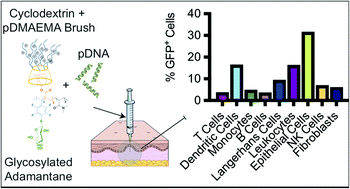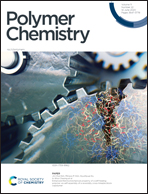Precisely targeted gene delivery in human skin using supramolecular cationic glycopolymers†
Abstract
Gene delivery has become the focus of clinical treatments, thus motivating delivery strategies that are capable of targeting certain cell types in the context of both vaccines and therapeutics. Here, we present a gene delivery platform enabled by host–guest interaction between a cyclodextrin with emanating chains of cationic polymers, poly(2-dimethylaminoethyl meth-acrylate) (PDMAEMA) paired with a glycosylated adamantane containing copolymer. By decoupling the cationic polymer and glycosylation chemistries, we were able to vary each independently to study the transfection efficiency both in vitro and ex vivo in human skin explants. Medium length PDMAEMA enabled optimal DNA complexation, and glycosylation specifically enhanced the number of cells transfected 100-fold in vitro and 3-fold ex vivo. Furthermore, these glycopolymers enabled greater immune cell up take, specifically in skin resident leukocytes. This platform is a facile and clinically translatable way to study how glycosylation affects cellular uptake and targeting in a complex cellular medium.



 Please wait while we load your content...
Please wait while we load your content...